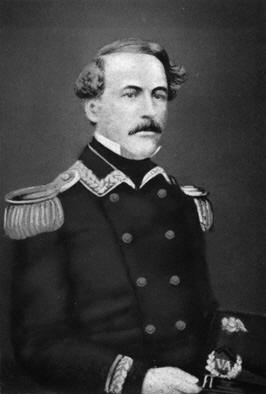Robert E. in TexasRobert E. Lee,
spent several crucial years of his early career in the US Army
serving in Texas. On March 3, 1855,
Congress had authorized two new regiments of infantry and two of
cavalry to help protect the 8,000-mile western frontier. At this
time, some 11,000 US troops were defending the frontier against
over 30,000 Indians, widely dispersed in raiding parties. Texas
had a frontier of more than 1,200 miles, with only 2,886 United
States officers and enlisted men to defend it.
Prior to 1855, Lee had held positions of military engineer,
astronomer, or staff-officer. As a result of Congress's
formation of two new regiments in 1855 Lee was called for the
first time to command men, and Lee was transferred from his
place of engineer to the post of lieutenant-colonel in the
Second Cavalry, one of the regiments in question. |

Robert E. Lee in Texas
|
The extraordinary number of names of officers in this regiment who afterward became famous is worth mentioning. The colonel was
Albert Sydney Johnston; the lieutenant-colonel, Robert E. Lee; the senior major,
William J. Hardee; the junior major,
George H. Thomas; the senior captain, Earl
Van Dorn; the next ranking captain, Kirby Smith; the lieutenants, Hood, Fields, Cosby, Major, Fitzhugh Lee, Johnson, Palmer, and
Stoneman, all of whom became general officers afterward on the Southern side, with the exception of Thomas, and the three last named, who became prominent generals in the Federal army. It is rare that such a constellation of famous names is found in the list of officers of a single regiment. The explanation is, nevertheless simple. Positions in the new regiments were eagerly coveted by the best soldiers of the army, and, in appointing the officers, those of conspicuous ability only were selected. The Second Regiment of cavalry thus became the corps d'elite of the United States Army; and, after Albert Sydney Johnston, Robert E. Lee was the ranking officer. After several months of court martial duty, Lee left for Texas. Soon after his arrival at
San Antonio on March 27, 1856, he was assigned to command the two squadrons of the Second Cavalry at Camp Cooper on the Comanche reservation in present Shackelford County twenty-five miles north of
Albany. On April 9 he arrived at his post, which for the next nineteen months he called "my Texas home." Camp Cooper was a lonely station. Rattlesnakes and wolves ranging about the post and neighboring wild Indians were ever present reminders of the frontier. But Lee adapted himself to his new work of supervising routine post life, of exploring the adjacent region for a new post site, and of keeping a watchful eye on the Indians. Also, he attended court-martial sessions at Fort Ringgold, Fort Brown, and at Indianola. Moreover, in June 1856, with four squadrons of cavalry from Camp Cooper and forts Mason and Chadbourne, he led a 1,600-mile expedition out to the foothills of the Llano Estacado and returned, scouting the headwaters of the Colorado, Brazos, and Wichita rivers. A brush with the Indians resulted in the capture of three Comanche prisoners. The expedition consumed forty days. On July 23, through the blazing heat of a dry summer, the troopers returned to their home post, having scouted completely valleys and canyons of nearby rivers and creeks. Lee presently heard of other Indian raids, but before he could organize a second expedition, he was called to San Antonio to take command of the regiment, since Johnston had been sent to
Washington. At San Antonio Lee's duties were more pleasing, but he did not remain long. On October 21 he also went to Washington to administer the estate of his deceased father-in-law. In October 1859 Lee commanded a detachment of marines which captured John Brown and his abolitionist followers. Lee remained with his family until February 13, 1860, and then returned to San Antonio to assume command of his regiment. For the next several months Lee, who opposed secession, had little time to watch the gathering clouds of civil war. On March 15 he left San Antonio for Fort Ringgold and Fort Brown to pursue Juan N. Cortina. Although he was unable to trap so slippery a foe, he succeeded in securing a promise from Mexican officials that they would effect the arrest. Eight months later he sought the seclusion of his regimental headquarters at Fort Mason; but on February 13, 1861,
General Scott ordered his return to Washington to assume command of the Union Army. Instead, Lee determined that he could not fight against his beloved state of Virginia and resigned his commission in the United States Army. Excerpts from: Robert E. Lee Biography
A LIFE OF GEN. ROBERT E. LEE.
BY JOHN ESTEN COOKE. R. E. Lee: A Biography
by Douglas Southall Freeman the Handbook of Texas Online |
